1955 – the last time we saw Newcastle United lift a major domestic trophy. Back then, the northeast club defeated Manchester City 3-1 to win the FA Cup. Fast forward 67 years and Eddie Howe’s team have a chance to make history once more, with only Man United standing between Newcastle and the League Cup.
Howe has received immense praise for what he has built at the club in such a short space of time, with UEFA Champions League qualification a real possibility for the Toon after a strong showing in the Premier League, but they weren’t able to match an in-form Manchester United on the big day, with the Red Devils collecting their sixth EFL Cup. This wrapped up a very successful week for the Old Trafford club, with this success coming after they knocked Barcelona out of the UEFA Europa League.
In this tactical analysis, we will dive into Erik ten Hag’s tactics that allowed his side to take a 2-0 lead into half-time, along with an analysis of what went wrong for Howe’s Newcastle side despite some strong attacking tactics.
Lineups
Eventual winners Man United went with a 4-2-3-1, with a host of changes to the lineup from the midweek triumph over Barca. Diogo Dalot came in at right back to replace Aaron Wan-Bissaka, while the rest of the backline remained unchanged. The same can be said of the two holding midfielders as we saw the duo of Fred and Casemiro start once again, with the latter getting himself on the scoresheet.
In the attacking area of United’s midfield unit, we saw more change – Jadon Sancho was dropped to make way for former Ajax star Antony who lined up on the right flank; Marcus Rashford on the left with Bruno Fernandes through the middle. Wout Weghorst stayed in the lineup to lead his side in attack.
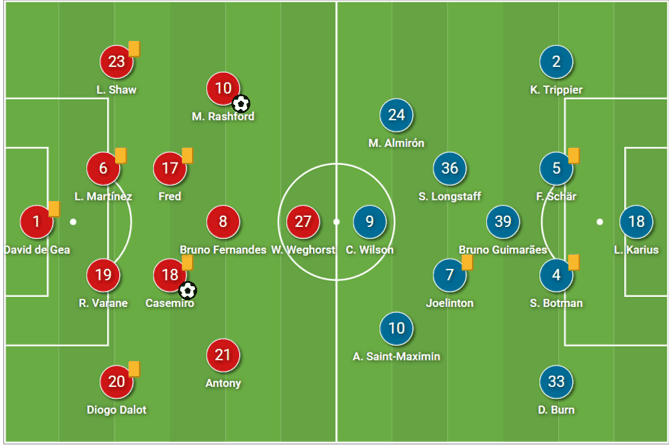
Newcastle opted for a 4-3-3 shape with a variation of one holding midfielder in Bruno Guimarães, with Joelinton and Sean Longstaff ahead of him. The major talking point for the media in the build-up to this game was Loris Karius being called upon to make a rare appearance, thanks to Martin Dúbravka’s cup-tied status and Nick Pope’s suspension following his red card against Karius’ former team Liverpool the week prior to the final.
Howe’s back four was unchanged from the Anfield defeat, but Joelinton’s inclusion in midfield came at the expense of youngster Elliot Anderson – the front three saw one change as well with Callum Wilson taking up the familiar central role in attack.
Man United’s build-up play: Fluidity and positional relationships
After what was arguably a slow start from ten Hag at United, their recent form combined with their performances are making Man United a threatening team once again. At his previous club, Ajax, ten Hag liked his players to attack with intensity and fluidity, using clever passing combinations and movements to slice teams open. This is discussed below, along with another interesting element of United’s tactics in possession: positional relationships, in particular the partnerships between Fred & Casemiro and Fernandes & Weghorst.
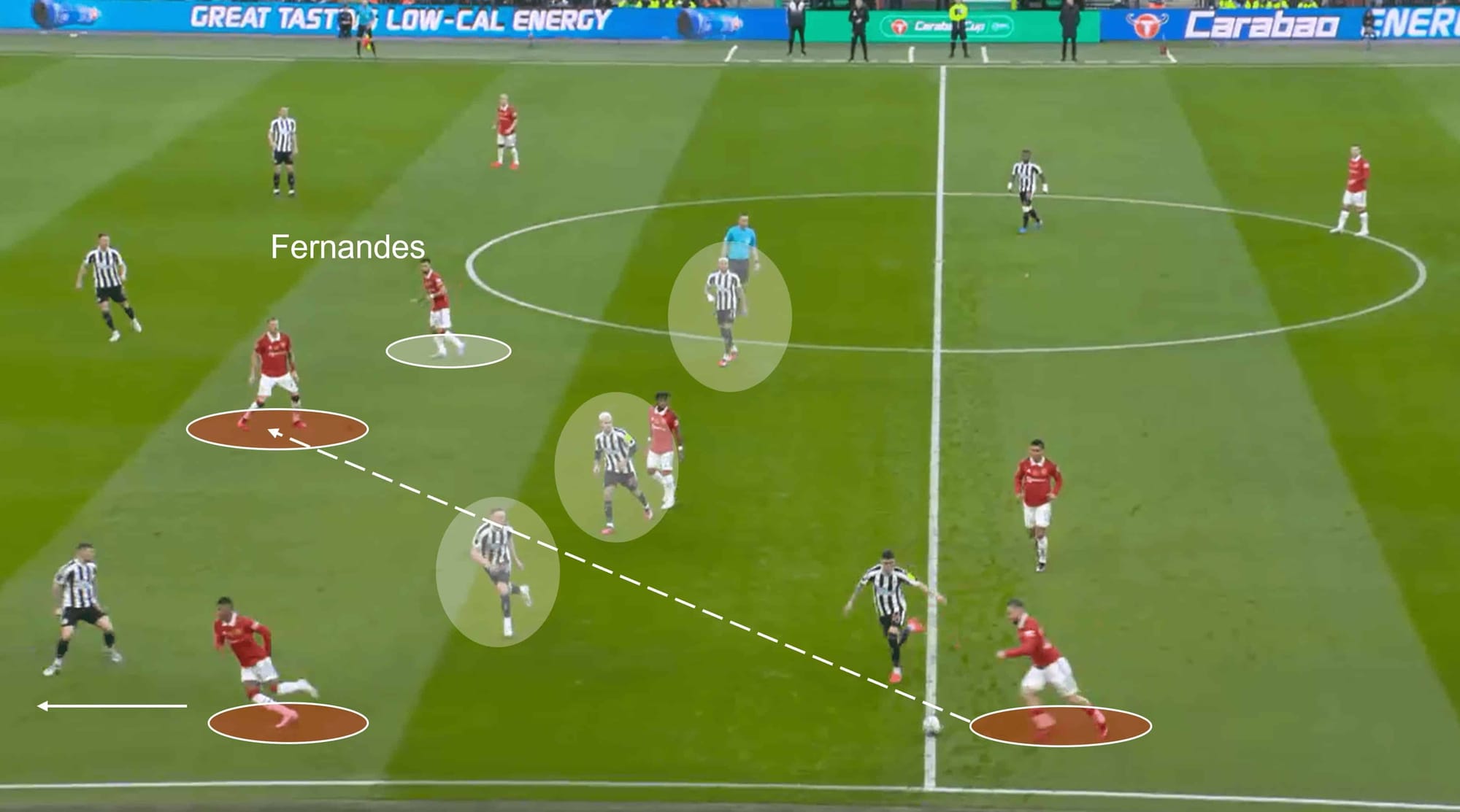
This move occurred within the opening minutes and served as an early warning to Newcastle. There are a number of noteworthy elements in the play, and we’ll start with Bruno Fernandes’ positioning in relation to Newcastle’s midfield unit. The playmaker is far away from the ball with several players closer to it than he is, suggesting that he is taking up a position to contribute to the attack in a later stage. He is also in front of the Newcastle middle three, meaning that Man United had a chance to cause real danger if they could eliminate that middle three – Fernandes would effectively become an extra forward.
The move itself was easy on the eye but should not happen from a Newcastle perspective. Luke Shaw catches the opposition midfield off guard, so much so that the England left-back is able to play a cutting pass through three opponents to find the feet of Weghorst. The target man had dropped in deeper to support the attack, and instantly played a well-executed pass into the left flank to meet the run of Marcus Rashford.
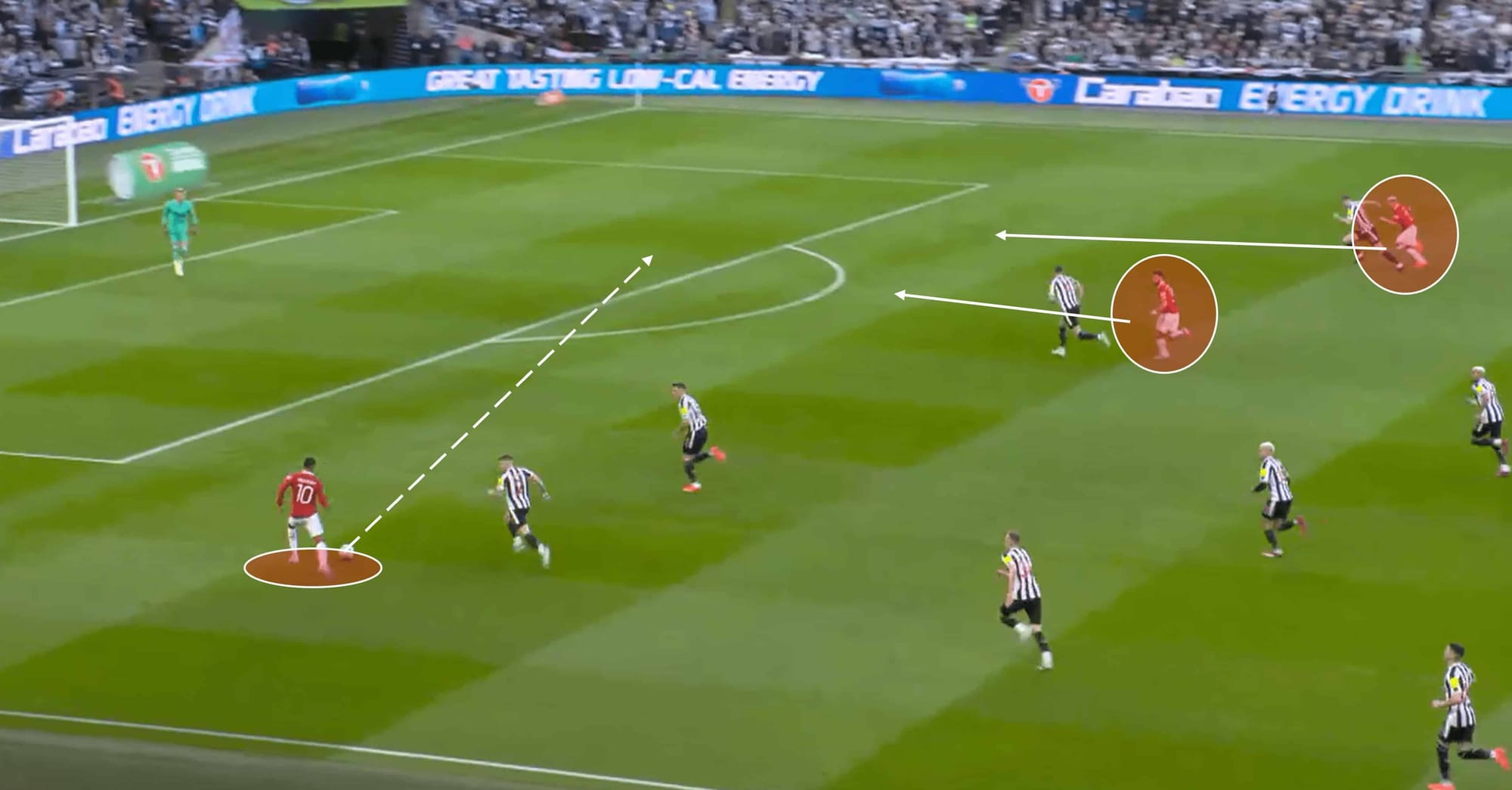
The speed and attacking intent of this early move would have pleased Manchester United fans as their team showed a direct want and understanding, and looked to play with a purpose. Finishing this move off was Rashford after he collected Weghorst’s pass, and the England international looked to maintain the pace of the attack by playing an ambitious first-time pass across the box, hoping to find either Antony or Fernandes.
While the pass was a creative one and really wasn’t too far from meeting Antony, if we look at this from a technical perspective, Rashford could have done more. He played the pass with the inside of his right foot, which limits the control he has of the pass’s direction – if he had used his left foot, he would have had the control to whip a curling pass across the Newcastle back four, which could have been far more dangerous. Nonetheless, this move summarised what was a bright start for the eventual champions.
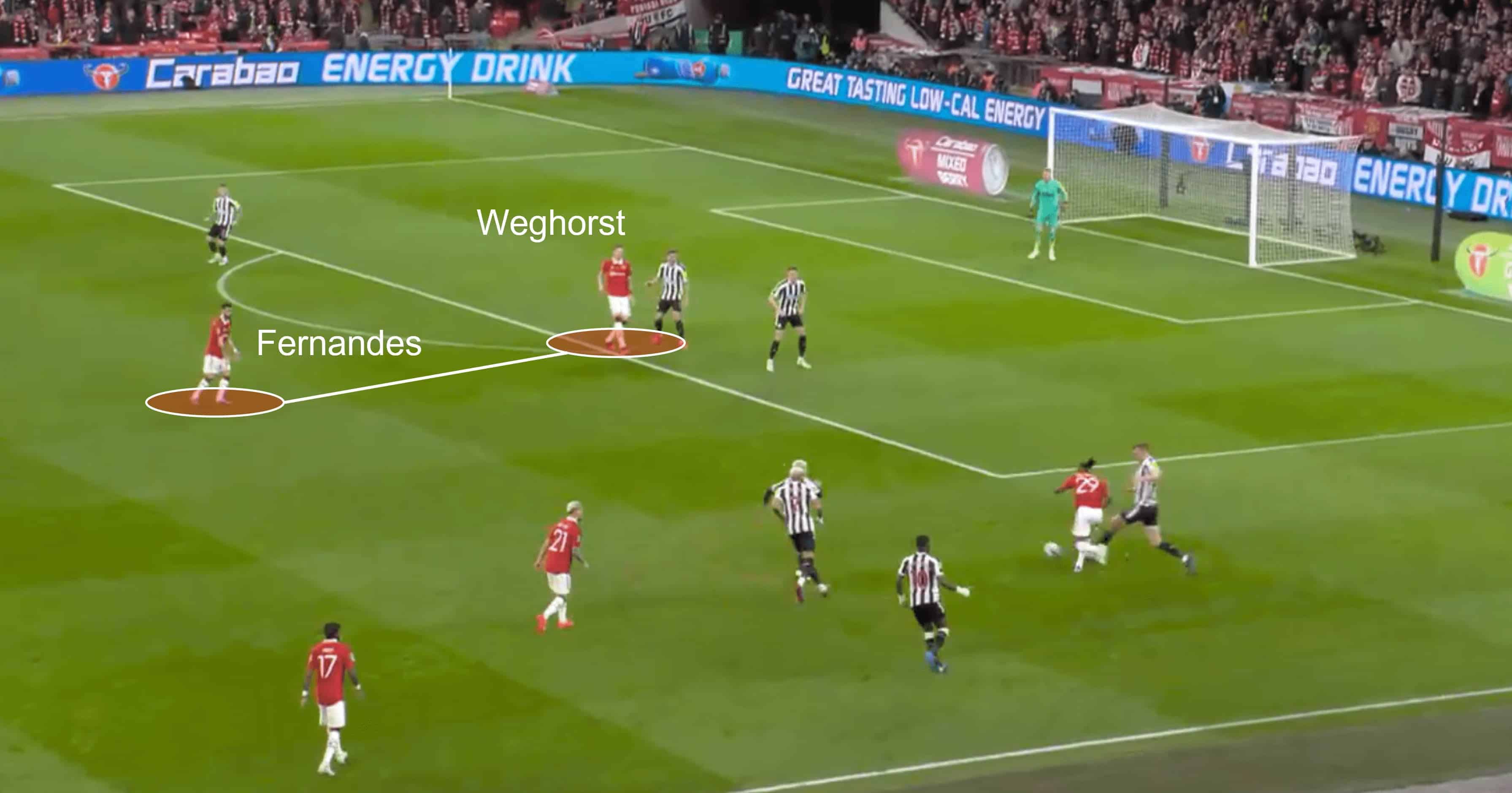
Moving on to the analysis of positional relationships, we learn more about Fernandes’ role in the United midfield. Actually, a lot of the time, the Portugal international played as a second striker behind Weghorst when his side had the ball, which involved staying in close proximity to the big striker. This allowed for quick interplay when ideal, but also produced the opportunity to execute the move of Weghorst dropping slightly deeper, giving Fernandes the space to run in behind him, looking to out-wit the Newcastle defensive ranks.
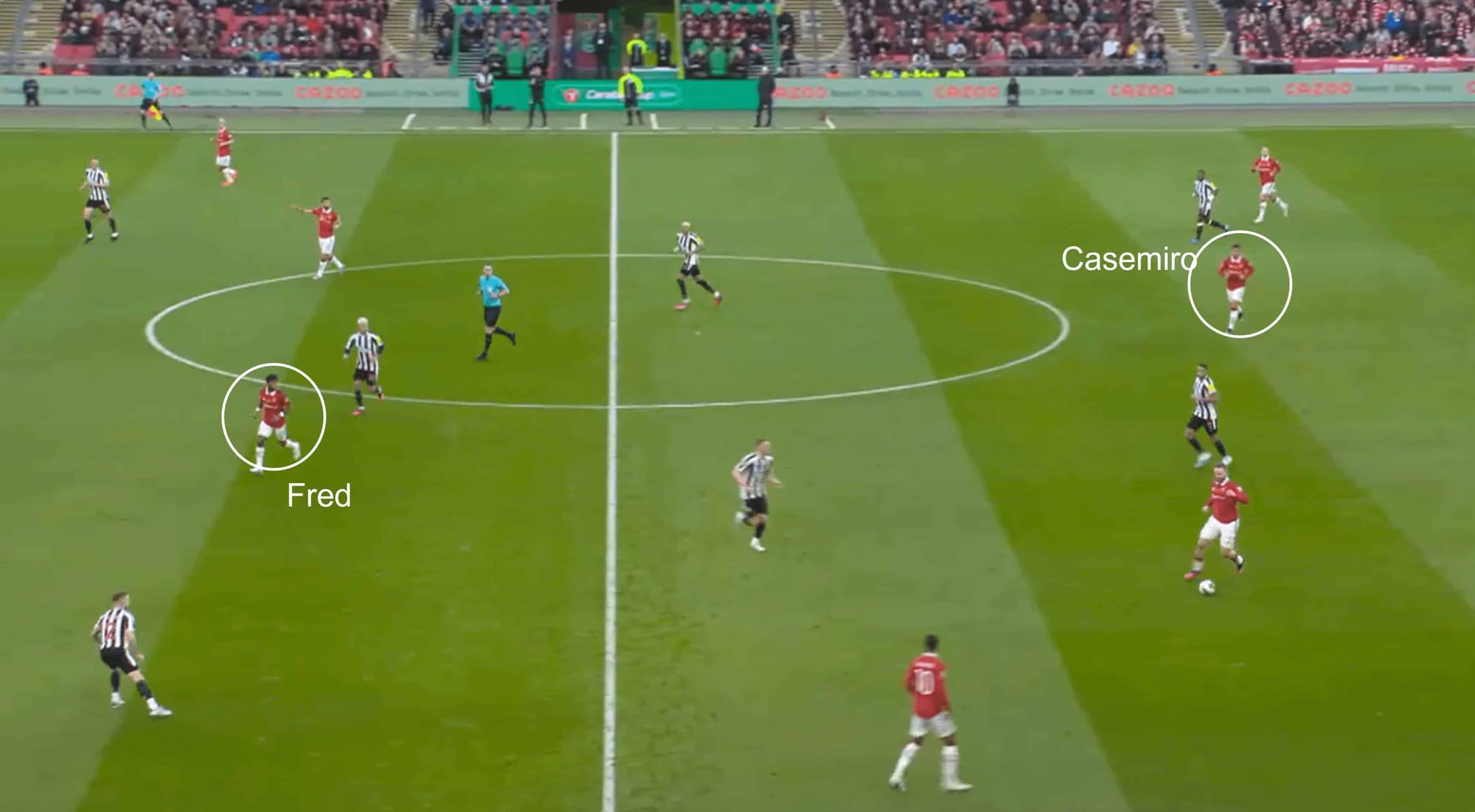
In the lineup visual earlier in this tactical analysis, you can see that, on paper, Fred and Casemiro lined up next to each other, but when United had the ball, this was rarely the case. Out of possession, Fred would usually be the one to chase down the opposition with high energy, with Casemiro sitting deeper and locked into a more central position to offer defensive support.
They mirrored this somewhat in their own possession, as Fred was often seen far higher up the pitch than his Brazilian teammate. Why? There are two possible answers – Casemiro is the stronger player defensively, so his presence gives some protection to his side in the event of an opposition counterattack. On the ball, Casemiro is more likely to be the type of player to spray passes out to the flanks while Fred gets involved in combination plays higher up the pitch.
Man United’s heavy attacking presence
In line with what we discussed in the previous analysis segment about Man United’s attacking with intensity, they also like to have a large presence in attack, showing confidence in the tactics as well as being able to exploit the aforementioned midfield shape and depth in the Newcastle ranks. Read on for an analysis of Manchester United’s tactics when looking to penetrate Newcastle with a heavy presence in high areas.
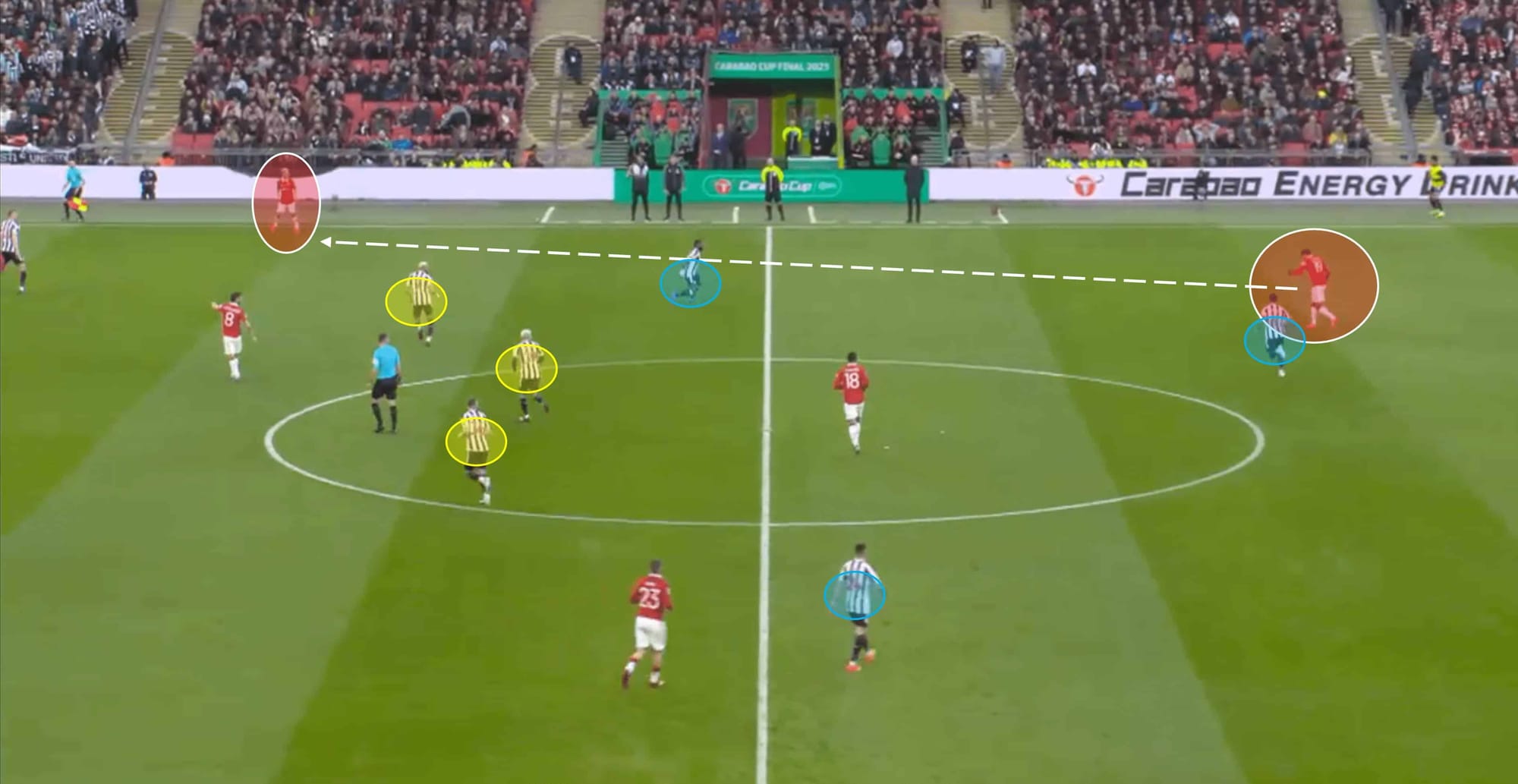
Newcastle’s shape out of possession really did invite their opponents on in certain areas, especially in the first half. Their midfield three was often very narrow but fairly high up, with the aim of limiting Man United’s forward passing options – their heavy attacking presence could have forced Newcastle into playing a deep defensive shape and this midfield setup was their way of combatting that. This would have worked better if their front three, particularly the wide players Allan Saint-Maximin and Miguel Almirón, pressed more effectively.
The lack of both pressing and marking from those two basically left them in no man’s land as you can see above. Saint-Maximin is offering very little to his team when he could at least cut the passing line out. Man United looked to capitalise on this, and looked to bring their heavy presence into play.
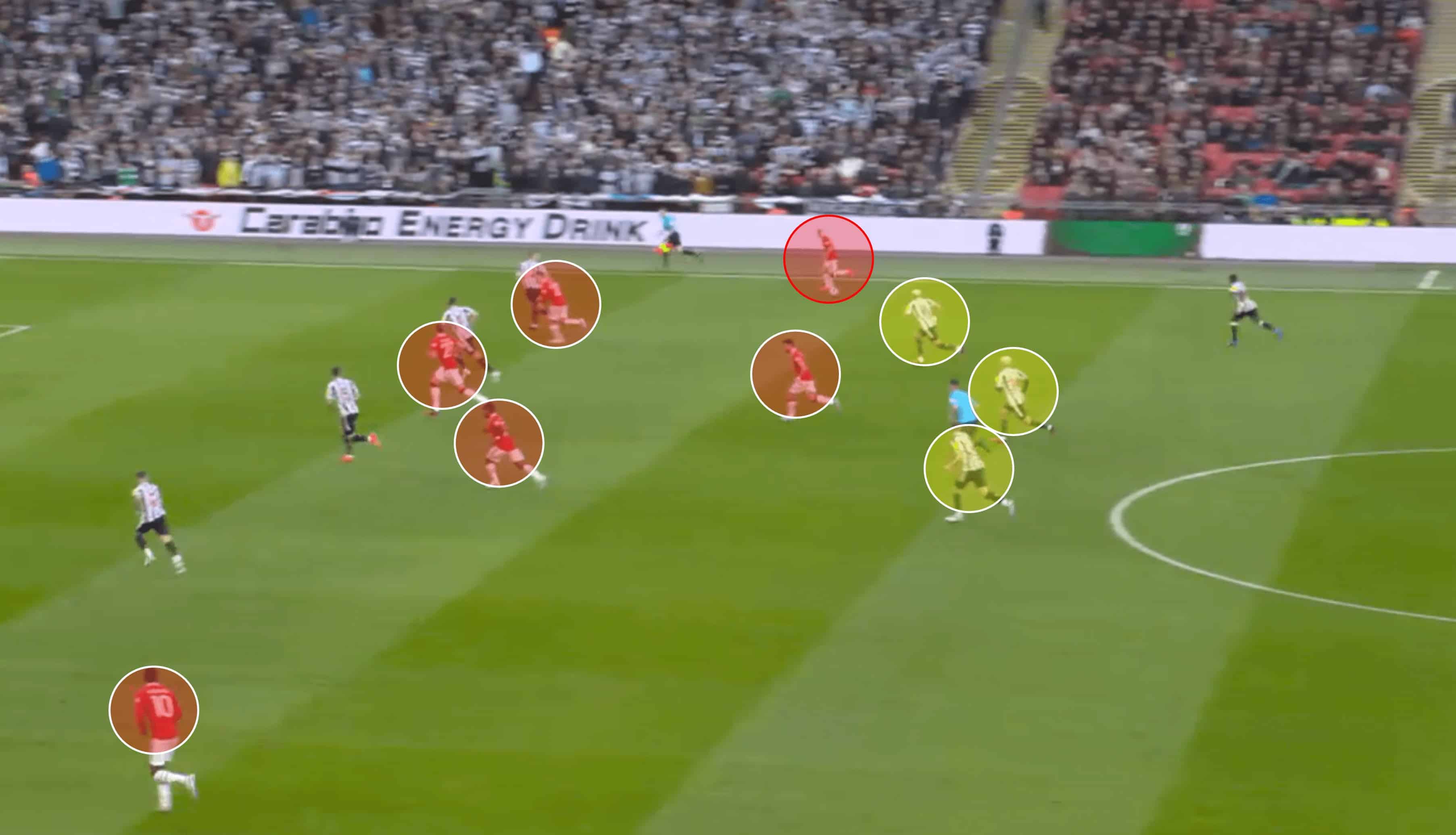
As you can see, that one pass out to Antony meant Manchester United had possession with six players ahead of Newcastle’s midfield three, making it a 6v4 scenario against Howe’s defensive unit. Antony utilised his pace to drive forward toward the final third, but he was unable to deliver a cross of any quality. Perhaps somewhat ironically, in this situation, it looked as though Antony felt rushed into playing an early cross to try and take advantage of his team’s presence in the final third. Newcastle got away with one in this situation.
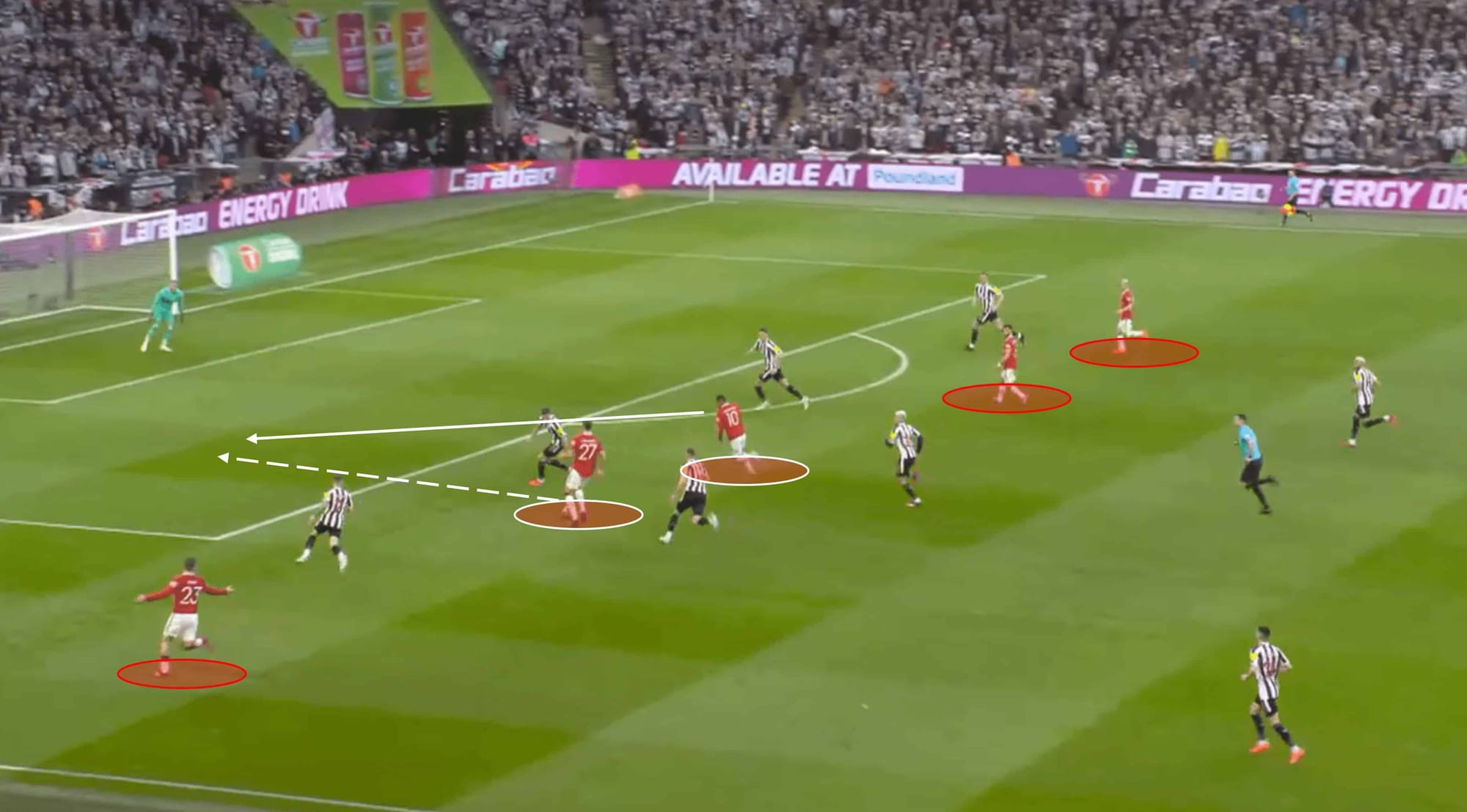
They weren’t so lucky in a later scenario. Following a turnover in midfield, Man United claimed possession and sprung forward with five players all looking to get in on the attack. Perhaps the slowest of those five, Weghorst, was the one tasked with carrying the ball toward the box as his teammates made supporting runs in varying positions. The Dutchman remained calm and picked the perfect pass – a through ball behind the Newcastle defence into the path of Rashford who struck the ball home with his left foot.
Yes, three of those players had no direct involvement in this move, but their presence in the move gave Newcastle too much to focus on defensively, which ultimately created the gaps they needed to get into a scoring position.
Newcastle’s struggle in front of goal
Eddie Howe’s team have become accustomed to controlling the majority portion of possession this season, and this cup final was no different, with Newcastle having 62% possession and making nearly double the passes of their counterparts. Regardless of this, they struggled to truly threaten ten Hag’s men, recording just two shots on target all game. In this final analysis segment, we will look at why the Toon struggled to find the back of the net despite some impressive build-up play.
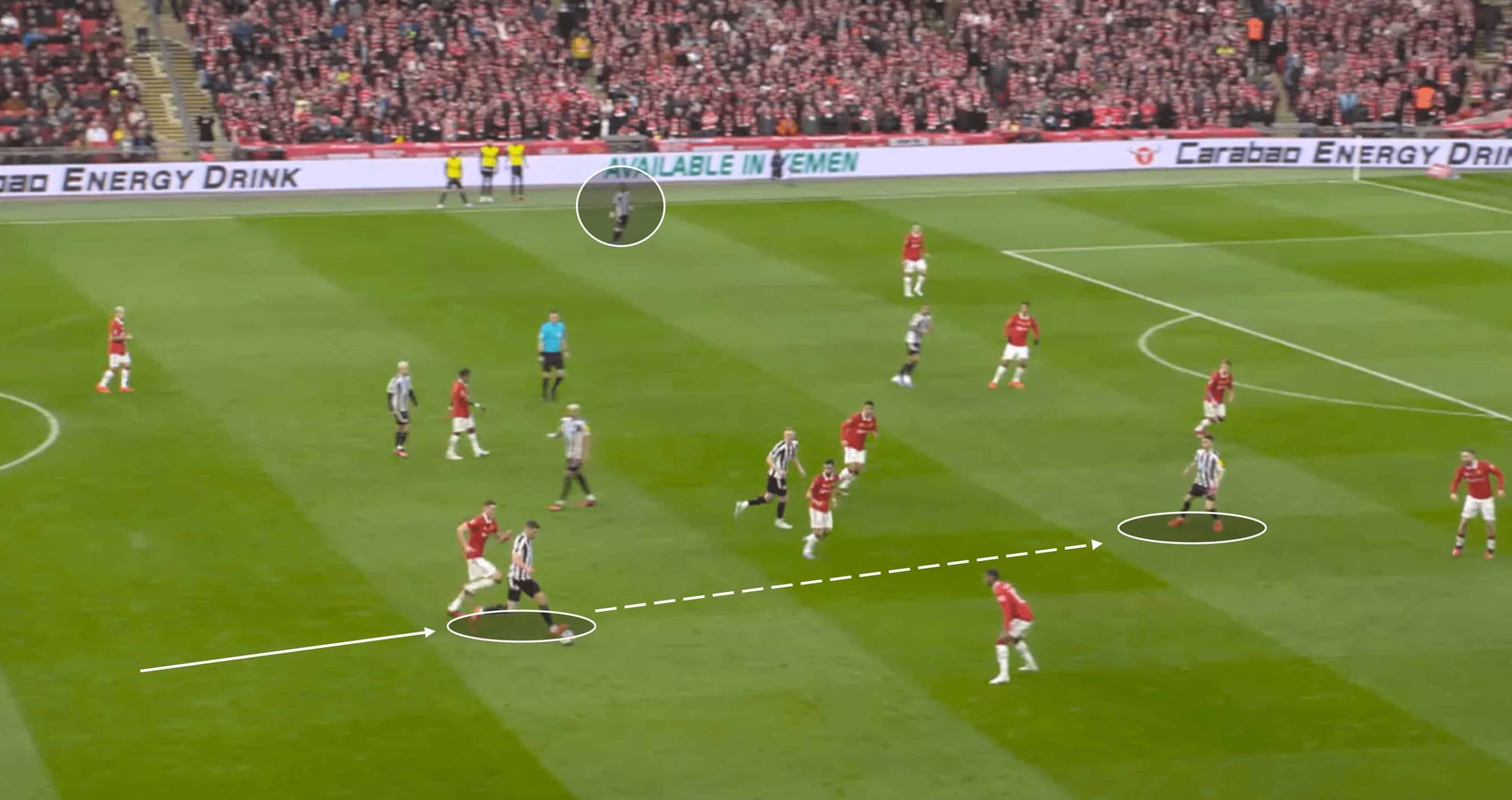
Getting the ball into the final third wasn’t a problem for Newcastle. In fact, they produced some excellent football to cut through their opponents at times. Above, for example, Fabian Schär, was able to breeze past Weghorst to take the ball into a more dangerous position, allowing him to play a penetrating pass into the feet of Almiron.
Newcastle did want to attack with pace and purpose, but they also knew that from time to time, they’d have to recycle possession, so we’d see them use a wide setup. As you can see above, Saint-Maximin is very wide on the left flank, which also stretched Man United’s defensive shape slightly too.
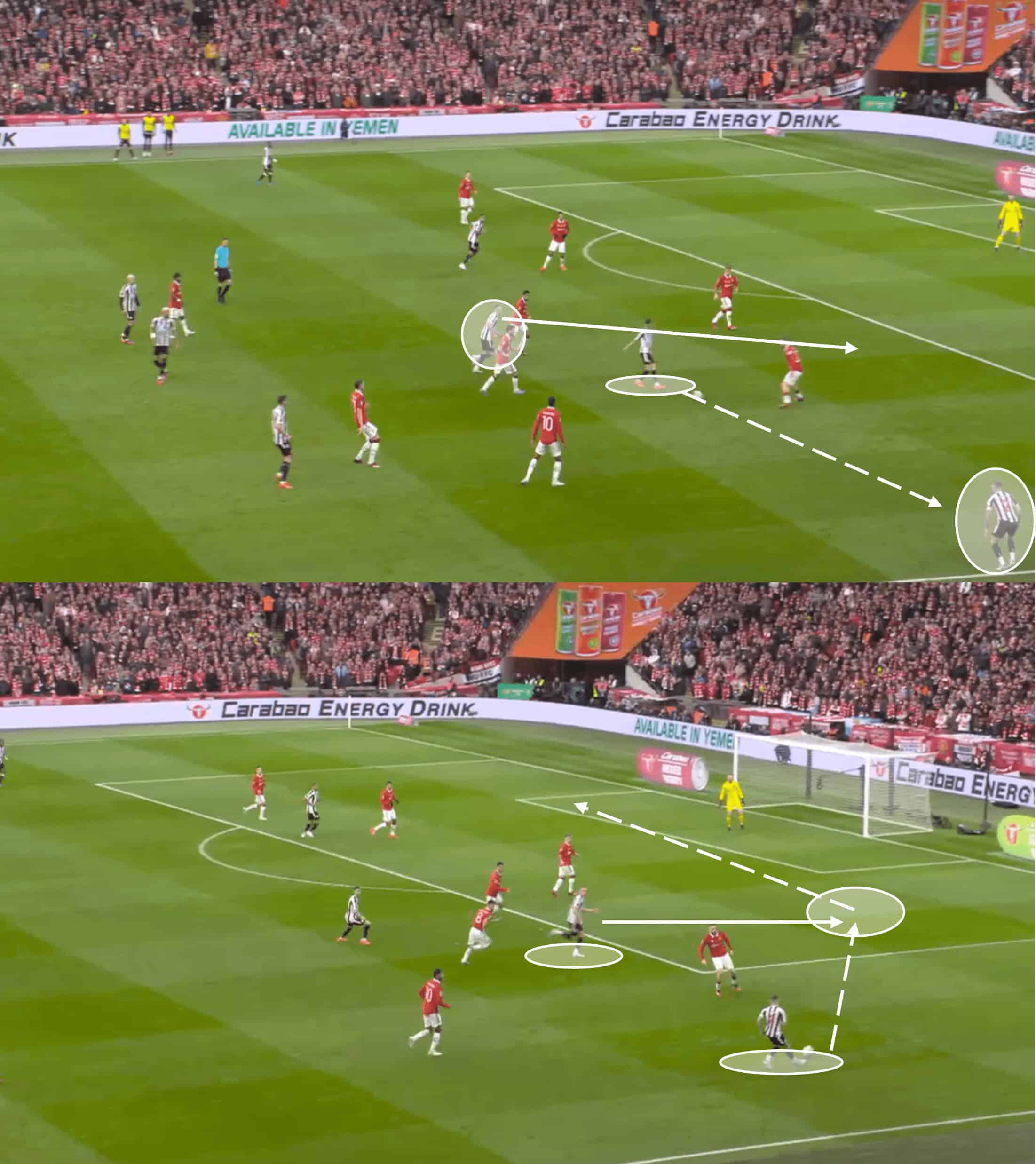
Upon receiving the pass, Almiron plays a clever first-time ball into the path of Kieran Trippier, with the former La Liga full-back eager to push on into the deeper zones of the final third. Take note of Longstaff’s third-man run – he starts to make his diagonal move into the box as Almiron is playing his pass out wide – perhaps an insight into what Howe has been working on during training.
Trippier’s ball into Longstaff is well-weighted, and Longstaff fires an inviting ball across the face of goal, a brilliant delivery, except there was nobody there to finish it off – the story of Newcastle’s afternoon.
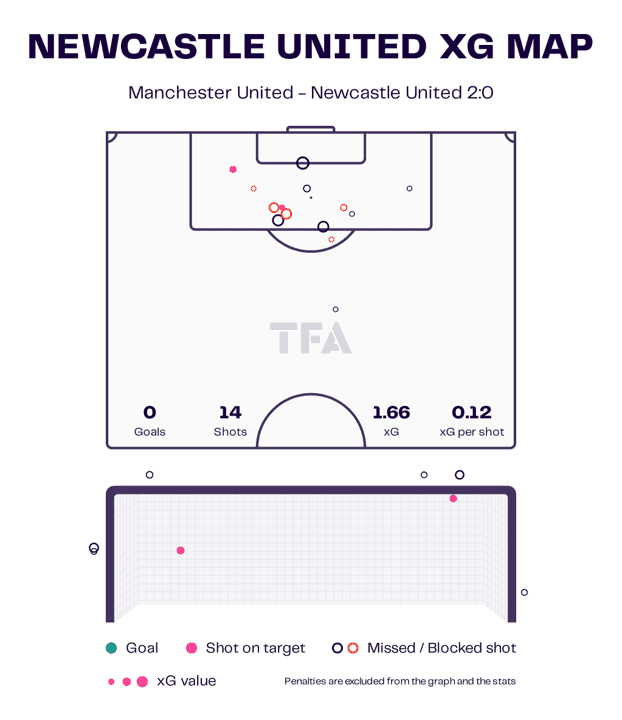
This xG map sheds some more light on how Eddie Howe’s side struggled in front of goal. While 14 shots is a strong amount for a cup final against such strong opposition, just two of them were on target, giving them an xG of 1.66. In reality, it’s probably fair to say Newcastle were unlucky not to have at least scored, but they needed to find that deadly edge at the end of a move.
Conclusion
A valiant effort from a club who are likely going to lift some silverware in the coming years, but Newcastle could not end their fans’ wait for a major domestic trophy this time. The club’s fanbase won’t be disheartened for too long, as their attention now turns back to the fight for Champions League football.
Manchester United were deserved winners, and those who doubted Erik ten Hag in his early days at the club may be changing their minds right about now, as we have seen some brilliant football from the former Ajax boss’ side.

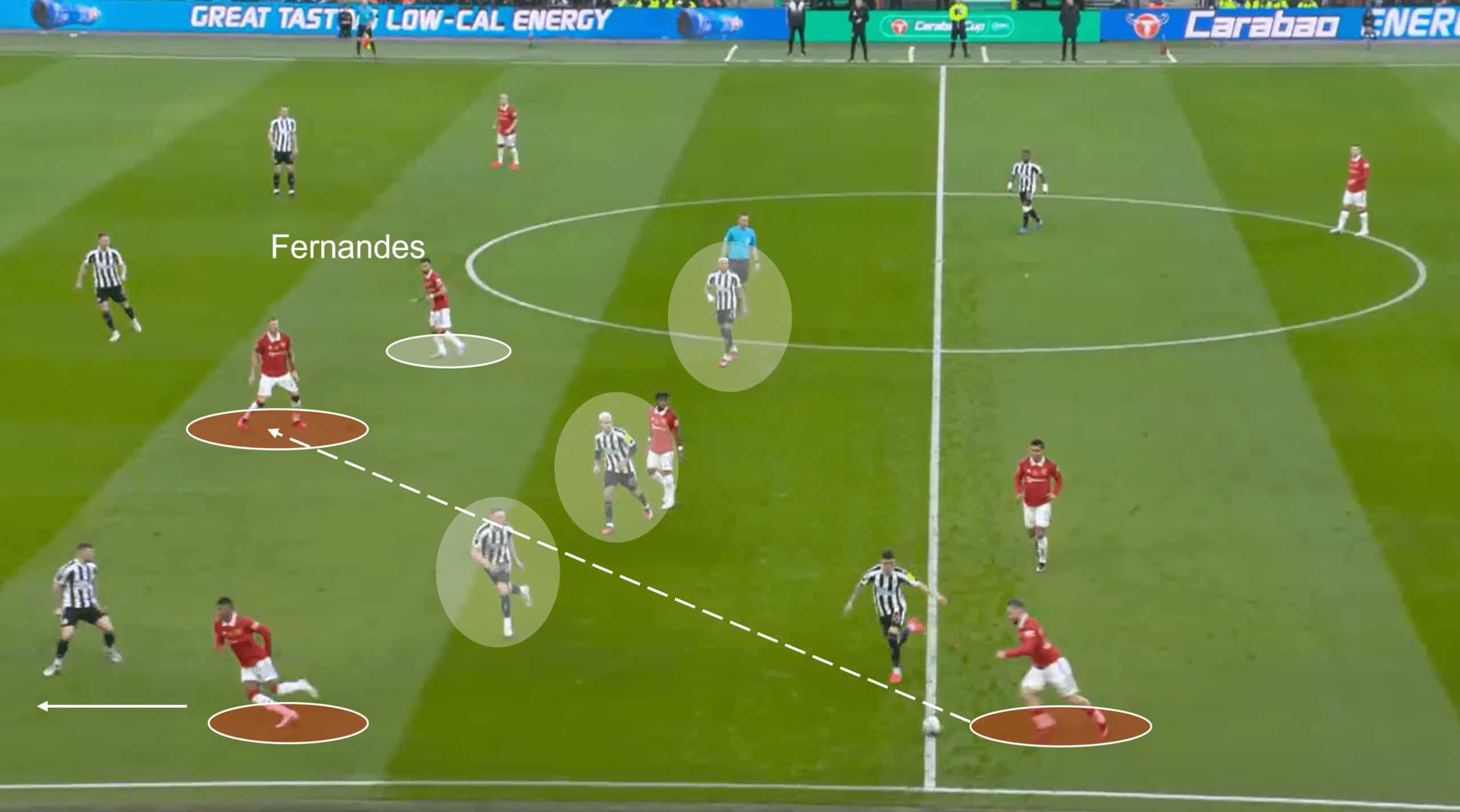




Comments